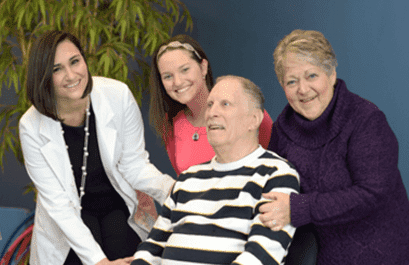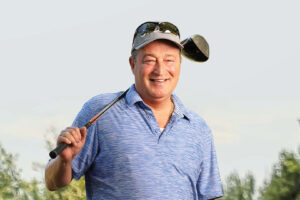Before the program, Mark Herman was falling frequently. “He was very unsteady,” his wife, Barbara, recalls. “Frankly, it was very frightening.”
Mark, a Jackson resident, had been living with Parkinson’s disease for the past four years, and his now 72-year-old body was having difficulty performing everyday tasks. His recurrent falls were posing a serious concern for his safety.
Before he started the CentraState’s LSVT BIG and LOUD program, designed to improve movement (BIG) and speech 8 (LOUD) in patients with Parkinson’s, Mark went through some physical therapy at other health care facilities. He was also given some exercises to do at home, which he was having difficulty completing. Determined to find a therapy routine that Mark could fully commit to, Barbara discovered CentraState’s program. After meeting with CentraState’s LSVT BIG and LOUD staff, including Shannon Lenahan, Mark’s BIG physical therapist, and Brittany Bonner, his LOUD speech-language pathologist, Mark was willing to give it a go.

The 16 physical and speech therapy sessions that make up the program weren’t easy, but Mark powered through them. Barbara says she realized the program was effective when Mark began to be very serious about doing the exercises at home. “I thought to myself that this is working not only physically but psychologically, too,” she recalls. “It was a big deal.”
Lenahan recalls that when Mark started the program, he would often take small, choppy steps, referred to as festinating. “This usually occurred when starting to walk, or when going around obstacles,” Shannon says. “The great thing about LSVT BIG is that we include functional tasks addressing the individual’s deficits.”
As part of the BIG program, Mark worked hard on picking up objects from various heights and being able to walk around obstacles without losing his balance. Initially, the tasks required all of his concentration to perform, but in four weeks, he was able to talk and perform the tasks without festinating.
“The program was not easy for Mark,” Lenahan says. “As he moved bigger and further into his range of motion, he experienced some soreness and back pain; however, he was able to work through the soreness and continue the program four days in a row. One of the main reasons the program has been so successful is the initiative the patients take and carry over to manage their progressive disease.”
As Mark continued to work hard, he realized that the program was making a real difference. “It was like a lightbulb going off. He never once stopped doing what he was supposed to do,” Barbara recalls. “At home, he would say to me, ‘When are we doing my exercises; I have to do my exercises.’ This is a guy who, once he retired, anything sports on TV was his life. And getting him up off that seat and moving was huge.”
Through the program, Mark learned to slow his movements and speech down, and control them to a degree. “He went from falling every day to twice a month, maybe,” Lenahan says.
Bonner points out that Mark was hardworking and highly motivated throughout the LOUD program. “When he began therapy, both Mark and his wife Barbara expressed concern that he was unable to participate in social situations at the level he used to,” she says. “Conversational loudness was a huge concern for him, and we targeted that daily during his sessions.”
Bonner says that over the course of therapy, Mark was able to drastically improve his loudness and has become more comfortable speaking at family gatherings and over the phone. “It’s a great feeling when a patient tells me, ‘My children can’t believe how loud I am!’” Bonner says. “Mark is very dedicated to continuing his daily exercises, which helps him to maintain his new LOUD voice.”
Barbara also thinks that Mark has become more self confident. “Our kids were very concerned as they were watching him basically deteriorate, and they’ve noticed an improvement,” she says. “He’s gotten more determined. He had been falling constantly—in the bathroom, getting out of bed, walking around. Now he has not fallen in weeks, which is just awesome. Even when he has a close call where he’s very wobbly and unsure of himself, he’s been able to catch himself, and that’s tremendous. He’s not afraid anymore.”





